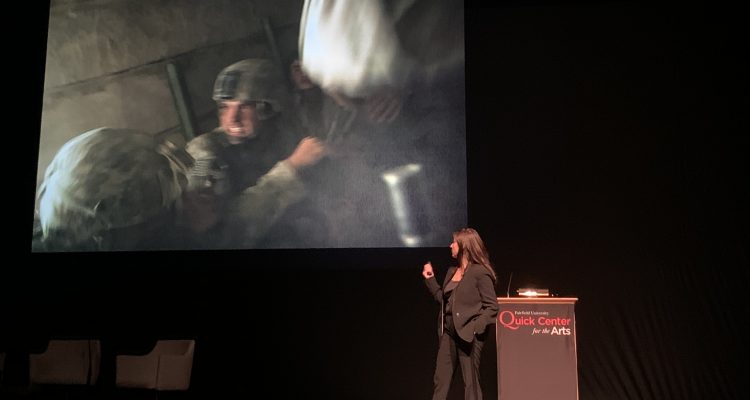There aren’t many people that can state casually that visiting Afghanistan while it was under the rule of the Taliban was something that made it comfortable to visit after 9/11, but then again, war photojournalist Lynsey Addario isn’t many people.
As part of the Open VISIONS Forum hosted at the Regina A. Quick Center for the Arts on Monday, Dec. 9 and presented by Bank of America’s “Women and Leadership” series, Addario spoke for over an hour about her decades-long career which has involved covering stories of war and chaos in varying regions of the world. While she did not get her start in these war-torn areas, her time there was bittersweet.
“For me I guess the big frustration was in the ‘90s I spent three years every single day covering New York City, covering the boroughs of New York and to not be there on 9/11 was really painful,” she told The Mirror. “It felt like that had become my story and where I learned how to be a photographer, and then I moved abroad in 2000 and was living in Mexico City when September 11th happened so it was very painful to not be in New York at the time.”
For Addario, what came next seemed like the logical thing to do. “I did what felt natural and that was to go where the story moved to, and that was to Pakistan and Afghanistan.”
Over the years since then, Addario has covered conflict in countries like Iraq, the Republic of Congo and Libya, depicting covering combat zones and the plights of civilians in striking imagery. Addario even found herself the target of this direct conflict when she and three other journalists were captured in Libya in 2011, where they were held for about one week while The New York Times negotiated their release. Needless to say, her life is anything short of dull.
While being in those situations consistently over the years has taken its toll on her, Addario has never thought about stepping away from what she does entirely. “For whatever reason, I think I have good coping mechanisms. This is a job that, most people who cover war, don’t last many years,” she said. “If you look at war photographers, they do that job for maybe seven years or ten years, and then they get burnt out and do something else. Now it’s been twenty years that I’ve been covering conflict, and I think the important thing for me is to be in tune with where I’m at mentally and if I feel like I need to step back, I do.”
“I have no problem stepping away from covering war or covering really tough subjects,” she continued on to say, “and I have to always listen to my instinct and be in tune with that, and I think for me that’s been something I feel comfortable with.”
Alongside her stories of traveling with American soldiers through Taliban-filled deserts and covering the lives of Sudanese refugees, Addario also highlighted a recent piece released on Sunday, Dec. 8 in the New York Times that is the result of three years of hard work. Following the life of Beligan Paralympian wheelchair racer Marieke Vervoot, Addario spent the last three years of Vervoot’s life covering the time between her last victory in Rio in 2016 to the final day of her life, when she passed away with the aid of physician-assisted suicide, or euthanasia.
The two became close friends over this time period, and Addario openly admitted that it was one of the toughest stories she has ever covered.
“I would go and sleep at her house because that was the only way to be able to tell her story, of how she’d have seizures in the middle of the night, how she would have to get injections in the middle of the night, so I was always there sleeping on her couch and we would leave long messages to each other when I wasn’t there,” Addario said. She was also there during the moments when Vervoot had her doubts about going forward with the procedure, but also when she became in too much pain to carry on.
Addario said, “And of course, she was a friend so I didn’t want it to happen, but also as a journalist you can’t influence them or say anything, so I was always there in support of whatever decision she made. It was really hard to be there with her in those final days, and it was hard to watch her die because she was a friend.”
Even in comparison to the turbulent scenes of war Addario has covered, Vervoot’s story stands alone. “I’ve covered very sensitive stories for over twenty years, and I’ve rarely met with someone who is so confident and comfortable being photographed in the most vulnerable situations,” she said.
Addario’s new book, “It’s What I Do: A Photographer’s Life of Love and War,” features photographs from throughout her career and is out now.


Leave a Reply